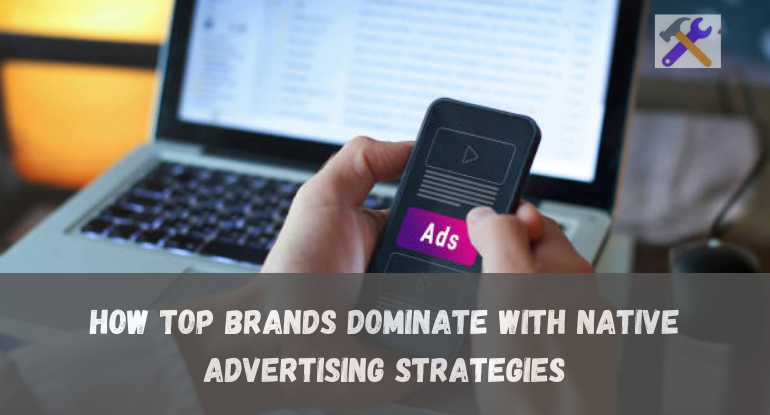
How Top Brands Dominate with Native Advertising Strategies
Nowadays, advertising has transcended the conventional realms of banners and pop-ups in a digital dispensation. A new frontier known as native advertising has risen, offering brands a potent method to intricately weave their messages into the very fabric of the content users are immersed in.
This approach not only fosters engagement but also cultivates a sense of trust between brands and consumers.
Let's take a closer look at how leading brands harness the power of native advertising to distinguish themselves amidst the bustling and competitive online sphere.
Introduction to Native Advertising for Brands

Native advertising is a strategic marketing approach that seamlessly integrates promotional content within a platform, harmonizing with the overall aesthetic and tone of the surrounding material. Unlike traditional advertisements that stand out conspicuously, native advertising is designed to blend in with the organic content on the platform.
The primary objective of native advertising is to deliver value and relevance to the audience while subtly introducing and promoting a brand, product, or service. By mirroring the format, style, and context of the platform, these ads create a more cohesive and less disruptive user experience.
This integration into the platform's environment makes native ads feel more organic, contributing to a smoother and more enjoyable browsing or consumption experience for users.
Through this approach, brands aim to build stronger connections with their target audience by providing content that aligns with their interests and preferences. By offering valuable and engaging information that doesn't interrupt the user's experience, native advertising has the potential to establish brand trust and credibility while achieving marketing objectives.
Understanding Native Advertising Strategies
Effective native advertising strategies rely on a deep comprehension of several key elements: the intricacies of the target audience, the nuances of the platform where the ads will appear, and the crucial aspect of content relevance.
Brands embark on a journey to create narratives that are not just persuasive but resonate seamlessly with the specific style and tone of the platform itself.
Central to these strategies is the meticulous understanding of the target audience—their behaviors, preferences, and interests. By delving into demographic data, user behavior patterns, and consumption habits, brands gain insights crucial for tailoring their content to captivate and engage the intended audience.
Moreover, successful native advertising goes beyond simply grasping the audience, it also involves a thorough comprehension of the platform's dynamics. Each platform possesses its own unique vibe, language, and user expectations.
Brands meticulously study these intricacies, ensuring that their native ads seamlessly blend in with the organic content, thereby enhancing the overall user experience.
Crafting compelling narratives forms the crux of these strategies. Brands invest time and effort into creating content that not only promotes their products or services but also aligns harmoniously with the platform's style.
This alignment ensures that the advertisement doesn’t disrupt the user’s browsing experience; instead, it merges effortlessly with the surrounding content, making it more appealing and engaging for the audience.
Ultimately, successful native advertising strategies are rooted in a thorough understanding of the audience, an adept grasp of platform nuances, and the artful creation of content that feels both native and valuable to the users.
Key Elements of Successful Native Advertising
Successful native advertising relies on relevance to the audience and platform, seamless integration with surrounding content, a focus on delivering value, and the strategic use of visually engaging elements to captivate and retain audience attention.
These elements work in tandem to create a cohesive and impactful native advertising campaign that resonates with audiences and achieves marketing objectives.
Below are the key elements of successful native advertising:
#1. Relevance: The cornerstone of successful native advertising lies in relevance. This entails a comprehensive understanding of the target audience's preferences, behaviors, and needs.
Ads must resonate with the specific interests and expectations of the audience while also aligning seamlessly with the context and tone of the platform where they are displayed.
By ensuring alignment with both audience interests and platform characteristics, native ads can effectively capture attention and engagement.
#2. Seamlessness: Native advertising's effectiveness hinges on its ability to seamlessly blend in with the surrounding content. This integration is not just visual but extends to the narrative and format.
Ads that mirror the appearance and feel of the platform's organic content are less disruptive and create a more immersive user experience. When executed seamlessly, native ads become almost indistinguishable from the surrounding material, fostering a sense of continuity and enhancing user engagement.
#3. Value-driven: The success of native advertising heavily relies on the value it offers to the audience. Content should go beyond mere promotion; it should provide genuine value by informing, entertaining, or solving a problem for the users.
By delivering meaningful and useful content, native ads establish credibility, trust, and authority for the brand. This value-driven approach not only captures attention but also encourages continued engagement and fosters a positive perception of the brand.
#4. Visual Appeal: Compelling visuals play a pivotal role in native advertising. High-quality, visually appealing content tends to capture attention more effectively than text alone.
Images, videos, infographics, or interactive elements not only attract users but also improve retention and comprehension of the message. Visuals serve as powerful tools to convey the brand's story, evoke emotions, and leave a lasting impression on the audience.
Top Brands Excelling with Native Advertising

Several prominent brands have demonstrated exceptional proficiency in leveraging native advertising strategies to connect with their audiences and achieve marketing success.
#1. BuzzFeed & Sponsored Content: BuzzFeed has emerged as a pioneer in creating compelling, shareable content for brands through their sponsored content initiatives.
By blending seamlessly into the BuzzFeed platform, sponsored articles, videos, and quizzes resonate with the audience's interests while subtly integrating brand messages.
Their knack for crafting engaging, entertaining, and informative content has allowed brands to reach BuzzFeed's extensive audience in a way that feels authentic and native to the platform.
#2. Netflix & Content Integration: Netflix has mastered the art of integrating products and brands into its original programming seamlessly. Through strategic partnerships and placements, they organically incorporate products or services within popular shows and movies.
This approach not only adds authenticity to the storyline but also exposes brands to a captive and engaged audience without disrupting the viewing experience.
Netflix's ability to merge brand placements with the narrative arc of their content has set a benchmark for effective content integration in the streaming industry.
#3. Airbnb & User-Generated Content: Airbnb has excelled in leveraging user-generated content as a form of native advertising. By showcasing authentic and diverse user experiences through their platform, they've created a community-driven approach to marketing.
User-generated stories, reviews, and content featuring unique stays and local experiences serve as powerful endorsements, instilling trust and authenticity in potential users.
This strategy humanizes the brand, allowing potential customers to envision themselves participating in similar experiences.
#4. NatGeo & Visual Storytelling: National Geographic has set a standard for native advertising through visual storytelling. Their collaboration with brands seamlessly incorporates sponsorships into their breathtaking visual content, including photographs, videos, and articles.
By aligning sponsorships with their editorial mission and high-quality content, NatGeo ensures that branded content remains both informative and visually captivating, resonating with their audience's interests in exploration, science, and nature.
#5. The New York Times & Paid Posts: The New York Times, with its 'Paid Posts' or 'T Brand Studio' initiative, has redefined native advertising in the realm of reputable journalism. They create bespoke content that blends seamlessly with their editorial standards while meeting the advertising objectives of brands.
Through high-quality storytelling and journalistic integrity, The New York Times elevates native advertising to a level where it complements the publication's credibility while delivering impactful messages for brands.
These brands stand as prime examples of how native advertising, when executed skillfully and authentically, can drive engagement, build trust, and deliver value to both the audience and the brand itself.
Implementing Effective Native Advertising Strategies
Implementing successful native advertising strategies involves a series of strategic steps aimed at seamlessly integrating brand messaging into the audience's natural content consumption experience.
#1. Researching Platforms: Brands embark on a journey of platform research, delving into the landscape of various digital platforms to discern where their target audience predominantly engages.
Understanding the preferences and behaviors of their audience across different platforms, be it social media, content-sharing sites, or specialized forums is pivotal.
This knowledge allows brands to tailor their native advertising efforts to fit the context, tone, and user expectations of each platform. By identifying these touchpoints, brands can strategically position their content where it's most likely to resonate with their audience.
#2. Creating Quality Content: At the heart of successful native advertising lies the creation of high-quality, engaging content. Brands invest in crafting narratives that captivate and resonate with users while aligning seamlessly with the native format of the platform.
These narratives go beyond traditional promotional content, aiming to entertain, educate, or solve problems for the audience. By prioritizing relevance and value, brands ensure that their content doesn't disrupt the user's browsing experience but rather enriches it.
Compelling storytelling, visually appealing graphics, and interactive elements contribute to creating content that seamlessly blends in with the platform's organic material.
#3. Collaborating with Publishers: Collaborating with publishers allows brands to leverage the established reach and audience insights of these platforms. Publishers possess a deep understanding of their audience demographics, behaviors, and preferences.
Through partnerships, brands gain access to valuable audience data and insights, enabling them to tailor their native advertising more effectively. By working hand-in-hand with publishers, brands can ensure that their content aligns optimally with the platform's ethos, resonating authentically with the audience.
These collaborations often result in more targeted and impactful native advertising campaigns.
#4. Data-Driven Optimization: Implementing native advertising strategies involves continuous monitoring and optimization based on data insights. Brands utilize analytics tools to track engagement metrics, conversion rates, and user feedback.
By analyzing this data, brands can refine their strategies, fine-tune content, and adjust targeting to better resonate with the audience. This iterative approach ensures that native advertising campaigns remain dynamic and responsive to audience preferences, maximizing their effectiveness over time.
Measuring Success and Adapting Strategies
measuring the success of native advertising involves a multifaceted approach beyond just tracking engagement, click-through rates, and conversions. Here are some additional aspects to consider:
#1. Audience Segmentation: Understanding which segments of your audience respond best to native ads is crucial. Analyze data to pinpoint demographic details, interests, and behaviors that correlate with higher engagement. This enables tailored ad campaigns for different subsets of your audience.
#2. Content Relevance: Beyond mere clicks, evaluating how well the content aligns with the audience's interests and needs is pivotal. High engagement might not always equate to successful conversions if the content doesn't resonate or lacks relevance.
#3. Quality of Engagement: Going beyond the quantity of clicks or views, assessing the quality of engagement is essential. Metrics like time spent on page, social shares, or comments can indicate deeper audience involvement and interest.
#4. Brand Perception and Recall: Tracking how native ads affect brand perception and recall is vital. Surveys, feedback mechanisms, and brand recall studies help gauge if the ads positively impact brand recognition and sentiment among the audience.
#5. Lifetime Value (LTV) of Customers: Evaluating the long-term value of customers acquired through native ads is crucial. Analyzing their purchasing behavior, retention rates, and overall contribution to the business can provide insights into the true impact of these ads.
#6. Competitive Benchmarking: Assessing your native ad performance in comparison to competitors can offer valuable insights. Understanding what strategies are working well for others in your industry can inspire new approaches or validate existing ones.
#7. Adapting for Various Platforms: Different platforms have varied audience behaviors. Adapting native ad strategies for specific platforms, such as social media, websites, or apps, ensures optimization and better resonance with users.
#8. A/B Testing and Iterative Improvements: Continuously experimenting with different ad formats, visuals, messaging, and placements through A/B testing helps in refining strategies. Iteratively improving based on these tests is key to staying relevant and effective.
#9. Integration with Overall Marketing Strategy: Native ads shouldn’t operate in silos. Integrating them cohesively within the broader marketing strategy ensures consistency and maximizes their impact within the entire marketing ecosystem.
#10. Regulatory Compliance and Ethics: Ensuring that native ads comply with ethical standards and regulatory guidelines is imperative. Unethical practices can damage brand reputation and affect long-term success.
Conclusion
Native advertising presents an avenue for brands to connect authentically with their audience. By delivering valuable content in a non-disruptive manner, brands can foster stronger relationships and drive meaningful engagement.
Embracing the key elements of native advertising and continuously refining strategies empowers brands to dominate in an ever-evolving digital landscape.
As the advertising landscape evolves, mastering native advertising strategies is essential for brands to thrive in the highly competitive online space. By understanding and implementing these strategies effectively, brands can truly dominate and resonate with their audience, fostering long-term relationships and brand loyalty.